Mary Anne Yarde's Blog: The Coffee Pot Book Club , page 158
January 8, 2019
The Magic of Sherwood Forest, by J.P. Reedman #RobinHood #Myths #Legends @StoneLord1
The Magic of Sherwood ForestBy J.P. Reedman

In British folklore, the two most famous figures are King Arthur and Robin Hood. Often, it seems they are almost ‘lumped together’, probably because both sets of legends contain feats of derring-do set within a medieval timeframe. However, when their stories are compared, there is one striking difference—magic, or lack of it.
In King Arthur’s tales, the supernatural is rife, despite the fact that there is some evidence Arthur may have been a historical figure, a Romano-British war leader of the so-called ‘Dark Ages’. Reading the body of the mythos, we encounter Merlin, lake faes, the Green Knight, giants, monsters, witches, otherworldly boars and many more fantastical beings.
Robin Hood is different. His tales appear, on the surface, to be merely stories of the ordinary man getting one over on his hated overlords—full of head-cracking quarterstaff fights, thievery at the expense of wealthy abbots, and outlaws feasting illicitly on the King’s deer in Sherwood.

Although some researchers have tried to pin Robin Hood to an actual historical figure, there is no single candidate that seems particularly convincing, especially since both Robin/Robert and Hood were common names in the Middle Ages, and the nickname Robbehod (Hooded Robber) was recorded since at least the 1200’s. A surname ‘Littlejohn’ appears in the record too. So Robin Hood is perhaps more of an invention than Arthur is…and yet his legends are far more mundane, with no magic or mysticism.
Or are they?
Thirty or forty years ago, theories abounded that Robin’s character was based on Robin Goodfellow, faery trickster and guardian of the forest—essentially a Green Man, the spirit of vegetation. The iconic 1980’s series Robin of Sherwood used these pagan and folkloric elements to give the Robin Hood legend a much-appreciated mystical touch with the first ‘good pagans’ ever shown on TV. However, despite the show’s continued popularity, the ‘Green Man’ interpretation of Robin seems to have fallen from favour in recent studies, which go for a more ‘literal’ approach to the outlaw’s origin.However, the wheel often turns full circle in the folklore study as in other fields, and the ‘pagan elements’ theory may yet come into vogue once more. I certainly can see what appears to be a mythic element in two traditional Robin Hood ballads. One is where Robin fights Guy of Gisburne who is dressed up in a stallion’s skin and head, certainly a rather odd addition to the story which is reminiscent of the Hobby Horse, which was brought out to dance at various celebrations and believed to have powers, often relating to fertility. This version is not the ‘jolly Robin’ of an Errol Flynn film; here, Robin decapitates Guy and mutilates his face.
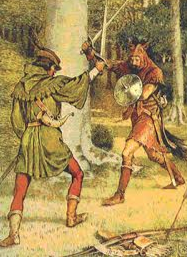
Then there is the fragmentary ‘Death of Robin Hood’ which appears in the 15th c Gest. Here, a sickly Robin, faring to Kirklees Abbey for healing, stumbles on an old woman squatting by a stream, lamenting loudly as she curses him. This figure is almost certainly what is known in Celtic mythology as a Bean-Nighe, the Washer at the Ford, who predicts the fate of those about to die.
The Gest continues with Robin fighting a knight with the vaguely sinister name of Red Roger before being bled to death by the treacherous prioress of Kirklees. This battle resembles the life and death struggle of the ‘Year King’, where a temporary chosen ‘king’ must fight another contender for his life, and the finale with its ritual blood-letting of Robin’s life-blood adds to a dark, unearthly feeling.
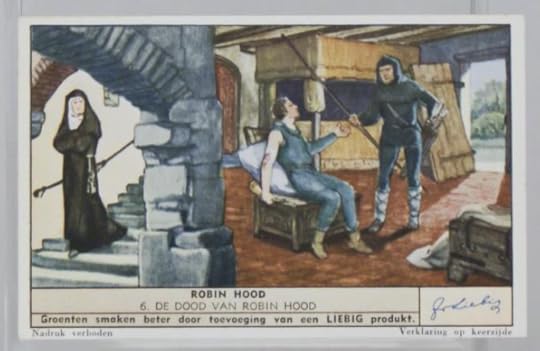
In my own novels of Robin Hood, the myths that lurk beneath the mundane veneer of the legends are deliberately brought to the fore, and blended with the local folklore of Nottinghamshire, Derbyshire and Yorkshire. Real history is not forgotten either, with the Siege of Nottingham and the Rebellion of William Longbeard being pivotal parts of the story.
The Hood GameRise of the Greenwood King
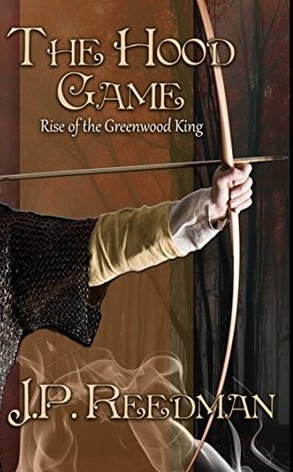
Battle. Betrayal. Blood-Feud
“The arrow swift to wound is already drawn from the quiver ; soon will the blow be struck ...”
Robin of Locksley joins the annual village games, signifying the ancient battle between the ‘Lord of the Hood,’ and The Dark.
A night of good cheer turns to terror as soldiers arrive to arrest Robin’s foster father, accused of poaching and witchcraft.
During a struggle between Robin and a Norman master, the lord is killed and Robin made “wolfshead” – a term for a hunted man with a price on his head. Joining with his cousin Scarlet, John Little and Much the Miller's Son, they must flee across the bleak moors of Derbyshire where Robin encounters St.Anne of the Well, who reveals the real meaning of the Hood Game ...
Seeking haven in the “Bright Forest,” others soon join Robin’s band, including the wild, drunken Irish bard, Alan of the Dale, Brother Tuck with his three wolfhounds, and the Lady Marion of Blidworth, rescued from the lecherous advances of Guy of Gisbourne.
Word then comes to Sherwood. The Devil is loose! King Richard Lionheart, freshly returned from captivity, retakes Nottingham back from the corrupt Sheriff, a supporter of Lackland. A chance encounter with Robin, and promises of pardons, brings the Lord of the Hood and his men into the Siege of Nottingham Castle ...
The Outlaws break free of the King's almost hypnotic hold, but Gisbourne is in pursuit using dark enchantments spun by the Witch of Papplewick.
Amazon
The Hood Game
The Head can only speak the truth. The Head can Prophecy.
The Head can track down the Greenwood King—even to London, where Robyn joins the doomed rebellion of the demagogue known to history as William Longbeard.
Amazon
J.P. Reedman
 J.P. Reedman is the author of historical fiction on Stonehenge, Robin Hood, Richard III and the Wars of the Roses and the lesser-known medieval Queens and Ladies.
J.P. Reedman is the author of historical fiction on Stonehenge, Robin Hood, Richard III and the Wars of the Roses and the lesser-known medieval Queens and Ladies. You can find J.P Reedman on Twitter.
Published on January 08, 2019 23:00
January 7, 2019
An Author’s Inspiration, by Minerva Spencer #amwriting #HistoricalRomance @MSpencerAuthor
An Author’s InspirationBy Minerva Spencer
I get this question a lot and I wish I had a concrete answer. Unfortunately--or fortunately, depending on how you feel about mystery--my brain creates stories at the oddest times.
I might be feeding my chickens and come up with the answer to a problem that has been bothering me for days. I often think about writing in the shower or on a walk or, especially, if I’m driving somewhere alone. I never turn on the radio so the silence and monotony in the car makes my brain start working.

So, I am not inspired by a specific event or thing, I think I come up with ideas when I’m not actively focusing on something else. I am also one of those writers who doesn’t know what she will write until after I’ve written it. I am amazed by what my fingers type on some days! Where did my clever hands come up with these ideas? Because my brain had no part in it.
When the writing urge strikes me I try to give it full rein. So I might write for 14 hours straight. I think my record is 60 pp in one crazed sitting. But most of the time I get out a couple thousand words a day. And then there are those days when getting a few words down is like bleeding.
My characters reveal themselves to me slowly. They aren’t taken from real life--unless I subconsciously collect bits and pieces--they are pretty much their own people. Most of them don’t look like real people, although I have to admit my hero from DANGEROUS my debut novel, looks a LOT like Ian Somerhalder, but a more mature and dignified version.
I came to writing late in life--at age 45--and I’m now 50, so I’m still learning a lot every day. I try not to examine my process too closely for fear of “jinxing” it. I know a lot of writers are very organized and methodical and have steps in their process. I wish I could do that, but it is a different process each time and inspiration has taken many forms. I’ve noticed that listening to another author talk about how they write almost always inspires me. I don’t know what it is, but I LOVE hearing how writers get the words down on the page.
Wherever I find my inspiration, I just hope I am lucky enough to keep finding it!
Barbarous(The Outcasts Book 2)

He could be her ruin
Hugh Redvers is supposed to be dead. So the appearance of the sun-bronzed giant with the piratical black eye patch is deeply disturbing to Lady Daphne Davenport. And her instant attraction to the notorious privateer is not only wildly inappropriate for a proper widow but potentially disastrous.Because he is also the man Daphne has secretly cheated of title, lands, and fortune.
She could be his salvation
Daphne Redvers’ distant, untouchable beauty and eminently touchable body are hard enough to resist. But the prim, almost severe, way she looks at him suggests this might be the one woman who can make him forget all the others. His only challenge? Unearthing the enemy who threatens her life . . . and uncovering the secrets in her cool blue eyes.
Amazon • B&N • Kobo
Minerva Spencer
 Minerva Spencer's brief author bio will tell you she has been a criminal prosecutor, college history teacher, and B&B operator. What it doesn't tell you is she also worked as a dock worker, ice cream manufacturer, reader for the blind, motel maid, and bounty hunter.
Minerva Spencer's brief author bio will tell you she has been a criminal prosecutor, college history teacher, and B&B operator. What it doesn't tell you is she also worked as a dock worker, ice cream manufacturer, reader for the blind, motel maid, and bounty hunter.Okay, so the part about being a bounty hunter is a lie.
Minerva does, however, know how to hypnotize a Dungeness crab, sew her own Regency Era clothing, knit a frog hat, juggle, rebuild a 1959 American Rambler, and gain control of Asia (and hold on to it) in the game of RISK.
DANGEROUS, the first book in Minerva's Outcasts series, is available for pre-order and debuts June 26, 2018. The Outcasts is a Regency Era series that features uncommon protagonists who face exciting challenges and unusual situations.
Read more at: www.MinervaSpencer.com. You can also sign up for Minerva's newsletter at this address, but no annoying pop-up window will nag you to do so.
Connect with Minerva: Website • Facebook • Twitter • Instagram
Published on January 07, 2019 23:00
January 6, 2019
A conversation with Dylan Casa del Lobos #HistoricalFiction #HistoricalRomance @Dylantheauthor
A conversation with Dylan Casa del Lobos
 Howdy, my name is Dylan Casa del Lobos. I am the author of Fifty Thousand Years
Howdy, my name is Dylan Casa del Lobos. I am the author of Fifty Thousand YearsHi Dylan, welcome to Myths, Legends, Books & Coffee Pots! Your book Fifty Thousand Years sounds amazing. What was the inspiration behind your book?
My first book, Fifty Thousand Years, was a project I considered during my days as an undergraduate, studying archaeology. I was intrigued by the assumption that only men created the tools of civilization, hunted for food, and solved every problem. Women were automatically assigned the roles of motherhood and perpetual cook. This didn’t sit well with me and contributed to the list of problems I found with the traditional study of archaeology, including a disconnect with basic survival and hunting skills in the mountains of the North.
Do you know, I have never even thought about that. Surely women would have known survival skills as well? I mean, why wouldn't they?!
Did you face many challenges while writing your book?
The challenges were to create a realistic look at life and the world, during many different eras and localities; since the story follows a genetic line of women from fifty thousand years ago to the present. The material is available, and the recent archaeological discoveries are fascinating. Although it was necessary to decide whose historical information was more credible, in order to portray the story as accurately and realistically as possible. There are many differing opinions in academia.
That is quite an epic endeavour. How did you even begin with regards to your research of the Ice Age?
I am from Northern Canada. During my youth, I worked as a professional hunter, trapper, ranch hand, and logger. Winter means working in forty below and colder. Sometimes, there are no warm places to rest and drink coffee. The short days of winter meant working all day in the cold, and sometimes sleeping in the cold. This outdoor lifestyle in the extreme cold has given me a greater appreciation of our ancestors’ survival skills during the Ice Ages and of how little mistakes can be fatal. My time as a hunting guide made me realize how difficult hunting the Mammoth, Cave Bear, and Cave Lions was with primitive weapons. I must add, I found the naïve assumptions about primitive hunting techniques, espoused by professors who had never stared into the eye of an enraged Grizzly, to be humorous and entertaining. I acquired a basic understanding of genetics and was complimented by a retired Stanford microbiologist for making the study of mitochondria DNA interesting and within the comprehension of the average reader. She told me, she didn’t believe it was possible. I consider that to be a great compliment. When I wrote of horse cultures and horses, the story went much faster. The story includes the 780-year Muslim occupation of Spain, the Spanish conquest of Mexico and Texas, and details the Oregon Trail during the mid-19th Century. I’ve started and trained oxen to work with the yoke, so this was easier for me to create the aspects of realism.
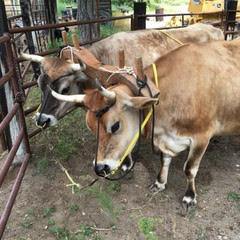 These are Brown Swiss yearlings and this is their first few minutes under the yoke.
These are Brown Swiss yearlings and this is their first few minutes under the yoke.They are contemplating mischief and mayhem.
I cannot imagine working in those sort of temperatures, let alone sleeping in them! But it obviously gave you a real insight to the tough conditions that your characters would have encounter.
What are you currently working on?
My present novel begins during the time of the earliest Eurasian horsemen, who became the mounted Scythian warriors, the Huns, and the Mongols. The story follows a genetic line of men and women, (The Hun women were warriors and rode beside the men) and describes their lives and horsemanship as they begin to question warfare and life itself. The story parallels the life of one of their modern relatives, a Marine who copes with the horrors of war and the adjustment to civilian life (I was a Marine during Vietnam). Besides the common DNA, a more natural and gentler horsemanship binds these men and the horses provide many of the answers to life’s mysteries and help these warriors cope, not only with training horses, but family members, strangers, and enemies as well. The ending has a few surprises as a modern day woman begins to unravel the code of her DNA.
That sounds amazing! Thank you so much for coming onto the blog and answering my questions. It has been a pleasure.
Fifty Thousand Years
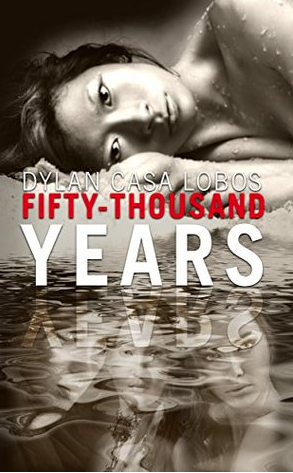
Fifty thousand years ago, much of the earth’s water was locked in ice sheets a mile high. The ice covered most of Europe, Asia, and North America. The oceans were 140 meters shallower and the rest of the world was in a 90% drought situation for tens of thousands of years.
Although, there was a unique biome for 300 kilometers south of the ice. Called the Mammoth Biome, this unique area was a savanna, with rainfall and runoff in the summer months. The runoff carved the river beds for the great rivers of Europe, Asia, and North America. The precipitation and runoff provided feed for a multitude of animals and our ancestors. Stretching from Spain to Siberia, across the Bering Strait on a landmass that was exposed by the shallow water of the Pacific, the Mammoth Biome continued across Alaska and into the Yukon. This is why we find the fossil remains of mammoths and many other Ice Age animals in the Yukon and Alaska. This landmass called Beringia was the main thoroughfare for early man to migrate into the New World.
The hunting and foraging for plant food was good, but danger lurked in the form of Cave Lions, Cave Bears, hyenas, and other humans. Only the strongest and most resourceful people could survive the full force of nature and living next to ice sheets that were thousands of miles long.
There are epic stories of survival and of solving solutions to serious problems of starvation and war, but Fifty Thousand Years is different, because women are participating and sometimes leading the various tribes.
Eventually, the weather changes and civilizations improve the quality of life, but the world is still a dangerous place, and families still need creative thinkers as well as bold leaders.
Amazon UK • Amazon US
Dylan Casa del Lobos
 Dylan Casa del Lobos is a horse dentist. He lives in Southern California and has an international practice. Dylan works without sedation and takes pride in being able to handle and work with thousands of horses, every year, without restraint or help. He has been a professional horseman for over 50 years and plans to continue working, until they give him his last biscuit. An outdoorsman, Dylan enjoys packing with horses in the mountains of British Columbia.
Dylan Casa del Lobos is a horse dentist. He lives in Southern California and has an international practice. Dylan works without sedation and takes pride in being able to handle and work with thousands of horses, every year, without restraint or help. He has been a professional horseman for over 50 years and plans to continue working, until they give him his last biscuit. An outdoorsman, Dylan enjoys packing with horses in the mountains of British Columbia.
Published on January 06, 2019 23:00
#NewRelease — Of Knights and Dogfights, by Ellie Midwood #Giveaway #HistoricalFiction
Of Knights and DogfightsBy Ellie Midwood

“Has it ever occurred to you, Johann; the fact that we’re fighting on the wrong side?”
Austria, 1938
On the verge of the most devastating war of all times, four young men found themselves sharing a room in a flying school dormitory. A bohemian Berliner, a Flieger-Hitlerjugend member, a prodigy pilot, and a butcher’s son, with nothing in common but their love for the Luftwaffe and the freedom the sky has to offer. The bond they develop is put to the test by what might be a stronger adversary - war itself. Over the English Channel, in the dusty skies of Africa, on the brutal Eastern front, they will discover where their loyalty lies, and what true bravery means.
“It’s Großdeutsches Reich, soldier. When one has a family at home, it doesn’t leave him many chances for the revolt.”
As the war progresses, Willi and Johann grow more and more disillusioned with the regime they’re protecting with their lives. An SS unit appearing on their base to claim one of their own; bits of conversation revealing the truth about the extermination program accidentally overheard during the official reception - the pieces of the puzzle are slowly coming together, but it’s too late to do anything but fight to the bitter end, whatever it may bring.
Set during one of the bloodiest wars in history, “Of Knights and Dogfights” is the story of the shattered illusions of youth, tyranny and freedom, friendship and love guiding one out of the darkest hell of Soviet captivity.
Amazon • B&N • Kobo • iBooks • Goodreads
Giveaway
Ellie Midwood is giving a way fiveebook copies of her fabulous book “Of Knights and Dogfights” plus a *$10 Amazon gift card as a bonus for the winner
To be in with a chance just answer this question...
What is your favourite movie set in a WW2 era?
Giveaway Rules
• Leave your answer in the comments at the bottom of this post.• Giveaway ends at 11:59pm GMT on January 31st.• You must be 18 or older to enter. • Giveaway is open INTERNATIONALLY for ebook. *US only for Amazon gift voucher. •Only one entry per household. • All giveaway entrants agree to be honest and not cheat the systems; any suspect of fraud is decided upon by blog/site owner and the sponsor, and entrants may be disqualified at our discretion.•Winners will be announced in the comments.
Ellie Midwood
 Ellie Midwood is an award-winning, best-selling historical fiction writer. She's a health-obsessed yoga enthusiast, a neat freak, an adventurer, Nazi Germany history expert, polyglot, philosopher, a proud Jew, and a doggie mama.
Ellie Midwood is an award-winning, best-selling historical fiction writer. She's a health-obsessed yoga enthusiast, a neat freak, an adventurer, Nazi Germany history expert, polyglot, philosopher, a proud Jew, and a doggie mama.Ellie lives in New York with her fiancé and their Chihuahua named Shark Bait.
Awards:
Readers' Favorite - winner in the Historical fiction category (2016) - "The Girl from Berlin: Standartenführer's Wife"
Readers' Favorite - winner in the Historical fiction category (2016) - "The Austrian" (honorable mention)
New Apple - 2016 Award for Excellence in Independent Publishing - "The Austrian" (official selection)
Readers' Favorite - winner in the Historical fiction category (2017) - "Emilia"
Readers' Favorite - winner in the Historical fiction category (2018) - "A Motherland's Daughter, A Fatherland's Son"
Connect with Ellie:
Website • Amazon• Goodreads • BookBub • Facebook.
Published on January 06, 2019 23:00
January 4, 2019
#BookReview — In the Shadow of the Storm: The King's Greatest Enemy #1, by Anna Belfrage #HistoricalFiction #Medieval @abelfrageauthor
Adam de Guirande owes his lord, Roger Mortimer, much more than loyalty. He owes Lord Roger for his life and all his worldly goods, he owes him for his beautiful wife – even if Kit is not quite the woman Lord Roger thinks she is. So when Lord Roger rises in rebellion against the king, Adam has no choice but to ride with him – no matter what the ultimate cost may be.
England in 1321 is a confusing place. Edward II has been forced by his barons to exile his favourite, Hugh Despenser. The barons, led by the powerful Thomas of Lancaster, Roger Mortimer and Humphrey de Bohun, have reasons to believe they have finally tamed the king. But Edward is not about to take things lying down...
Adam fears his lord has over-reached, but Adam has other matters to concern him, first and foremost his new wife, Katherine de Monmouth. His bride comes surrounded by rumours concerning her and Lord Roger, and he hates it when his brother snickers and whispers of used goods.
Kit has the misfortune of being a perfect double of Katherine de Monmouth – which is why she finds herself coerced into wedding a man under a false name.
Domestic matters become irrelevant when the king sets out to punish his rebellious barons. The Welsh Marches explode into war, and soon Lord Roger and his men are fighting for their very lives. When hope splutters and dies, when death seems inevitable, it falls to Kit to save her man – if she can.
In the Shadow of the Storm is the first in Anna Belfrage’s new series, The King’s Greatest Enemy, the story of a man torn apart by his loyalties to his lord, his king, and his wife.

There is no greater crime than to overthrow a King.But what if that King were corrupt? What if he threatened the very security of the kingdom he ruled?
Abducted and imprisoned against her will, Kit has no one to turn to for help. Lady Cecily de Monmouth, a stranger, has announced that Kit is to take the place of her half-sister — a sister Kit knew nothing about — and marry Adam de Guirande. If Kit refuses, not only will she be labelled a bastard, but the tenants of Kit’s beloved childhood home of Tresaints will also be made destitute. She has no choice.
Adam de Guirande has heard many rumours about the daughter of Thomas de Monmouth — she is a wayward woman of loose morals. However, his wife is not like this at all. Katherine is no shrew. No wanton. In fact, Katherine is the complete opposite of what he had been expecting. It was as if she were a different person altogether. Much to his surprise, Adam finds himself falling in love with his bride.
While Adam puzzles over his wife’s true identity, war is rumbling on the horizon. It is the utmost betrayal to bear arms against the sovereign King. Those who do, never die well. However, Adam’s Lord, the powerful Roger Mortimer, demands such a sacrifice. Edward II is a weak man and an appalling ruler. The time has come to free England of this pathetic weakling. But they all know that Edward will not surrender his throne willingly. Adam’s greatest fear is that Edward will not submit at all. If that is the case, then may God have mercy on their souls…
From the marital bed to the Tower of London, In the Shadow of the Storm: The King’s Greatest Enemy #1 by Anna Belfrage is one of the most compelling Medieval Historical Romances that I have ever read.
From the gripping opening line, I was hooked. Belfrage has penned an utterly enthralling account of a very turbulent time in British history.
Belfrage has the unique ability to make people who have been dead for almost 700 years breathe again. With a keen eye for historical detail, Belfrage brings not only a sensitivity to her narrative, but she writes as if she were a custodian of the history. The time, this place, these people, are safe in Belfrage’s capable hands.
Belfrage’s ability to combine a great story with a wonderful historically accurate backdrop — with all the dangers of rebellion and the threat of death and torture, as well as the lighter moments of first love, marriage and a growing family — makes In The Shadow Of A Storm a vastly entertaining tale which is incredibly difficult to put down. There are enough twists in this book to keep the reader on their toes, and wanting — no, begging — for more.
Adam and Kit make the perfect protagonists for this incredibly emotional tale of love, war, betrayal and death. Belfrage paints a dazzling portrait, filled with adventure, romance and intimacy. They are unforgettable characters embroidered into the backdrop of a dangerous and unpredictable time in which their tale is set. I adored both of them. The trials and tribulations that Adam suffers made me care for him as a character even more than I thought I would. He isn’t a perfect man, and he doesn’t pretend to be, but he does try to do what is right, and he is willing to learn from his mistakes. Adam has no easy time of it — he experiences the most horrific things. But not once does he let it break him, which is what made him so appealing, and so very likeable. Like Adam, Kit is a brave and determined protagonist. She is resolute that her husband will come home. Kit’s courage matches his. She is a woman in a man’s world, and yet, she will do anything to secure Adams life. Kit is the epitome of what a protagonist should be.
Adam and Kit’s goodness, their sense of fairness, is sorely tested when they are put up against the corrupt and evil, Hugh Despenser. Despenser was a character that I despised with every fibre of my being. He considers himself untouchable because of his favoured position with the King, and therefore his arrogance knows no bounds. He is a malicious and cruel man. His actions are utterly deplorable. Despenser is the kind of character that makes you want to throw the book across the room in outrage, only to instantly pick it up again, so you can find out what he is going to do next! As a historical character, Despenser was fabulously portrayed. And although we may never know the depth of his crimes — for it is the winner who gets to write history — I thought his characterisation was in keeping with the stories and the records about him from that time.
I cannot praise this book enough. I loved every word, every syllable, and every sentence. When historical romance is written this way, there is no such thing as too many pages. This is a must read if ever there was one.
I Highly Recommend.
Review by Mary Anne Yarde.The Coffee Pot Book Club.
Amazon US • Amazon UK
Anna Belfrage
 Had Anna been allowed to choose, she’d have become a time-traveller. As this was impossible, she became a financial professional with two absorbing interests: history and writing. Anna has authored the acclaimed time travelling series The Graham Saga, set in 17th century Scotland and Maryland, as well as the equally acclaimed medieval series The King’s Greatest Enemy which is set in 14th century England. She has recently released the first in a new series, The Wanderer. This time, she steps out of her normal historical context and A Torch in His Heart is with a fast-paced contemporary romantic suspense with paranormal and time-slip ingredients.
Had Anna been allowed to choose, she’d have become a time-traveller. As this was impossible, she became a financial professional with two absorbing interests: history and writing. Anna has authored the acclaimed time travelling series The Graham Saga, set in 17th century Scotland and Maryland, as well as the equally acclaimed medieval series The King’s Greatest Enemy which is set in 14th century England. She has recently released the first in a new series, The Wanderer. This time, she steps out of her normal historical context and A Torch in His Heart is with a fast-paced contemporary romantic suspense with paranormal and time-slip ingredients.Find out more about Anna by visiting her website, or herAmazon page.
Published on January 04, 2019 23:30
Shakespeare’s Richard II, by Mercedes Rochelle #History #MiddleAges #NewRelease @authorrochelle
Shakespeare’s Richard II
by Mercedes Rochelle
Like many of us, I first learned of Richard II from Shakespeare. Even though I knew nothing about him, I was totally moved during the prison scene while he bemoaned the fate of kings—and I never recovered! But his story goes way beyond the events of this play; in fact, Shakespeare only covered the last year of Richard’s life. He tells us nothing about what led up to the famous scene between Bolingbroke and Mowbray, where their trial by combat was interrupted and they were sent into exile. This was indeed the crisis that led to the king's downfall, but Richard's story is much more complicated than you would ever think from watching the play.
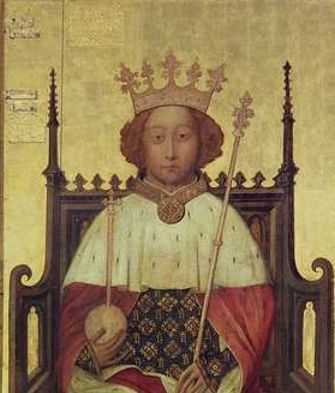
Richard II Westminster portrait. Source: Wikipedia
First of all, did you realize that Henry of Bolingbroke was Richard's first cousin? The clues are all there but it's not easy to put them together. The old John of Gaunt ("This blessed plot, this earth, this realm, this England...") was the eldest of Richard's surviving uncles, and because Richard was childless he was next in line to the throne (debatable, but that's another story). Bolingbroke, Gaunt's eldest son, was next after him. This did not appeal to Richard; in fact, according to all reports, having Bolingbroke as his heir was anathema. Why? Events in my book, A KING UNDER SIEGE, will give you a good idea. Richard and Henry were never friendly, but during the second crisis in Richard's reign, Bolingbroke was one of the Lords Appellant—the five barons who drove the Merciless Parliament to murder the king's loyal followers.

The five appellants before the king. Source: Wikimedia Richard's minority was not easy. The doddering Edward III was hardly a role model, and neither was his father, the ailing Black Prince who languished for years, disabled and debilitated. On Edward III's death, Parliament insisted on Richard's coronation instead of a regency; many feared that John of Gaunt would seize the throne. Nonetheless, what could one expect from a ten year-old? Four years later, the boy king proved himself worthy during the Peasants' Revolt, but his subsequent attempts to assert himself led to conflict with his magnates. His bad temper, sharp tongue, and impetuous nature gave the restive barons plenty of excuses to hold him down. Richard's solution was to surround himself with cooperative friends and advisors and exclude the self-righteous lords from his inner circle, which infuriated them. The king needed proper guidance, they insisted; his household needed purging.The Lords Appellant, as they came to be known, threatened Richard with abdication—humiliating him and destroying his power base. At first there were three of them: Richard's uncle Thomas Duke of Gloucester, Thomas Beauchamp Earl of Warwick, and Richard FitzAlan Earl of Arundel. After Richard's aborted attempt to raise an army in defense, Henry of Bolingbroke and Thomas Mowbray joined their ranks—the same who challenged each other in Shakespeare's play.
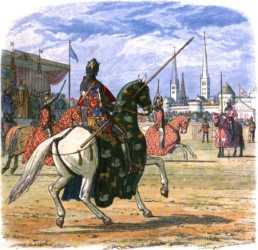
Richard Stops the Duel Between Hereford and Norfolk from "A Chronicle of England" illustrated by James William Edmund Doyle. Source: Wikimedia
So you can see that Shakespeare's trial by combat had a lot more going on than could easily be explained. Richard may have appeared detached while he observed the quarrel between Bolingbroke and Mowbray, but under his regal bearing he must have been shivering with glee. The altercation between these two knights was actually the result of their involvement in the Merciless Parliament. A year before the play took place, Richard had already succeeded in wreaking revenge on the original three Appellants. Mowbray feared that their turn was next, and when he voiced his concerns to Bolingbroke, the latter tried to save his skin by telling the king. The argument escalated from there, giving Richard the perfect opportunity to get rid of both of them. He made his fatal error when he went too far and deprived Bolingbroke of his inheritance. Shakespeare gave us the poignancy of Richard's last days. Historians have left us more of a conundrum which may never be sorted out. Richard's 22-year reign can be divided into two parts: the 12 years of his minority and the ten years of his majority—each of which are brought to a tragic climax. Hence, it will take two books to cover his story. As you might guess, volume two will be called THE KING'S RETRIBUTION.
A King Under SiegeBook 1 of The Plantagenet Legacy
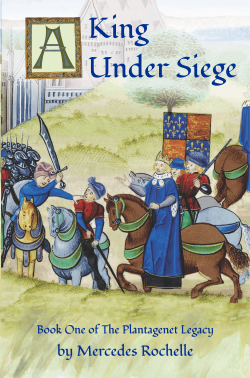
Richard II found himself under siege not once, but twice in his minority. Crowned king at age ten, he was only fourteen when the Peasants' Revolt terrorized London. But he proved himself every bit the Plantagenet successor, facing Wat Tyler and the rebels when all seemed lost. Alas, his triumph was short-lived, and for the next ten years he struggled to assert himself against his uncles and increasingly hostile nobles. Just like in the days of his great-grandfather Edward II, vengeful magnates strove to separate him from his friends and advisors, and even threatened to depose him if he refused to do their bidding. The Lords Appellant, as they came to be known, purged the royal household with the help of the Merciless Parliament. They murdered his closest allies, leaving the King alone and defenseless. He would never forget his humiliation at the hands of his subjects. Richard's inability to protect his adherents would haunt him for the rest of his life, and he vowed that next time, retribution would be his.
Excerpt
Chapter 1
Ten thousand or more crowded the banks of the Thames near the King's manor of Rotherhithe, shrieking and howling like the demons of hell. The royal barge, hung with the Plantagenet lions, floated safely in the middle of the river, while King Richard gripped his sword, trying to emulate his royal forefathers. His elders would agree that the fourteen year-old monarch looked every bit the Plantagenet successor; he was tall for his age, with delicate features and red hair like his father. Richard was born to be king and now he must prove it—though at the moment he felt more like a lamb than a lion.He waited for the frenzy to exhaust itself. "Why are you here and what do you want?" The young voice, clear and shrill, reached its listeners who broke out once again into a clamor, shaking their farm tools and rusty old blades. "Come to the shore!" One voice carried over the din. "Speak with us in person!" Standing under a large red canopy with his counsellors, Richard glanced upriver at the four smaller barges serving as his escort. The boats had hung back, not daring to come any closer. This was a sorry plight his advisors had led them into! Sighing, Richard turned to Archbishop Sudbury; he could see the terror in the prelate's face. This wasn't helping."I p-promised I would speak with them," the King said uncertainly. "I must at least try."Bristling under two great banners with St. George's cross and forty pennons, the mob continued its uproar while the King turned to his other advisors. Sir Robert Hales, England's treasurer, stepped up beside the archbishop. "We can't expect any mercy from them. They are out for blood." Richard frowned, dissatisfied. Hales might be Lord Grand Prior of the Knights Hospitaller, but today his courage seemed to have fled. The man's eyes were almost bulging from his head. Richard then turned to the Earl of Salisbury, the most experienced soldier on the barge. "And what is your advice?" he asked, trying to keep a brave face. "You cannot go ashore. They might restrain you—hold you hostage, or worse. This is an undisciplined rabble." This was the best counsel they could give him? He had to do something, though his advisors would probably criticize him for making the wrong choice—with the utmost courtesy, of course, and polite language. Taking a deep breath, Richard turned back to the crowd. He hoped he could control his stutter. "What is it you want from me?" he shouted. "Tell me, now that I have come this far."He stood, arms crossed, while the men closest to the river conferred with each other. Finally, coming to a decision, the apparent leader got into a boat with a couple of rowers. They brought their craft as close as they dared. "Here is what we want," the man called. "We demand the heads of John of Gaunt, Archbishop Sudbury, Treasurer Hales, Chief Justice Robert Belknap, Robert Plesington Baron of the Exchequer, John Legge and Thomas Brampton.""Why, you seek to deprive me of my chief ministers," Richard cried. Behind him, he could hear Sudbury calling down God's curses on their heads. "We seek to save you from corrupt officials," the rebel shouted back."By killing them all? How would that help me?""They are destroying the country with their dishonest administration." "This is too dangerous," Salisbury spoke in Richard's ear. "We must leave."Nodding in agreement, the King tried one last time. "If you wish to continue negotiations," he called, less sure of himself, "you may do so at Windsor on Monday next." While he was speaking, the barge was already turning around. Stunned at losing their advantage, the crowd howled in anger and the rebel boat fell back in confusion. But Richard no longer cared. He was headed for the safety of the Tower, though for the first few minutes they were at the mercy of any archer who might choose to draw his bow. Fortunately, nothing happened aside from the shouts of "Treason! Treason!" that diminished as they gained speed. The King stared at the receding mob, biting his lip, until they were out of range. He had never felt so alone. This debacle was not of his making, yet everyone was looking to him for a solution. It just wasn't fair. Even though he had been king for four years, he was in leading reins just as assuredly as any young horse. He sat in council meetings—even presided at Parliament—but his opinions were politely dismissed. They said he was too young, too inexperienced to make decisions. He was expected to watch and learn while his chief ministers made a mess of things. Well, they certainly taught him what not to do! And now, with half the country in an uproar, all they could do was dither. No one had taken the rising seriously enough to gather a force to confront the rebels, and now that the angry multitude was at the gates of London, no one had a suggestion what to do about it. Obviously, this attempt had failed disastrously. But at least he had tried.
Amazon UK • Amazon US
Mercedes Rochelle
 Born in St. Louis MO with a degree from University of Missouri, Mercedes Rochelle learned about living history as a re-enactor and has been enamored with historical fiction ever since. A move to New York to do research and two careers ensued, but writing fiction remains her primary vocation. She lives in Sergeantsville, NJ with her husband in a log home they had built themselves. Mercedes loves to hear from readers. You can find her: Website • Blog •Facebook • Twitter.
Born in St. Louis MO with a degree from University of Missouri, Mercedes Rochelle learned about living history as a re-enactor and has been enamored with historical fiction ever since. A move to New York to do research and two careers ensued, but writing fiction remains her primary vocation. She lives in Sergeantsville, NJ with her husband in a log home they had built themselves. Mercedes loves to hear from readers. You can find her: Website • Blog •Facebook • Twitter.
Published on January 04, 2019 23:00
January 3, 2019
Writing in the void – though, is that really true? By Nancy Jardine #amwriting #RomanBritain #HistoricalFiction @nansjar
Writing in the void – though, is that really true?
By Nancy Jardine
“How do you write a full length novel when there’s almost nothing written about the era?”
My answer is to look at sources beyond the scant written ones to create credible characters and realistic settings. That’s what I’ve done when writing my Celtic Fervour Series set in late 1st century A.D. barbarian Roman Britain. The Ancient Romans conceptualised that territory which hadn’t been invaded, subdued and officially absorbed by them into the Roman Empire was outside their boundary – and barbarian.
 Brigantia.
Brigantia.North England was occupied by the Brigantes Federation of tribes and some Late Iron Age neighbours. Sometime after the Claudian invasion of Britannia in A.D 43, Brigantia’s ruler – Queen Cartimandua – gained client-kingdom status from Rome, meaning her territory was loyal to Rome yet could remain virtually barbarian, so long as they posed no threat to Roman occupation south of Brigantia. However, by c. A.D. 69, highly volatile situations changed the status quo!
After the suicide of Emperor Nero in June A.D. 68, civil war raged across the Roman Empire till Vespasian (4th new emperor of A.D. 68/69) established control across the whole empire. During this period, Roman military rule was vulnerable in Britannia.
In A.D. 69, civil war also rippled across Brigantia. Venutius, ex-husband of Queen Cartimandua, took advantage of the Roman Empire chaos and raised an army to confront Cartimandua. Roman troops sent to aid Cartimandua meant pitched battles between Venutius and Rome, shattering the stability of the area.
Everywhere north of Brigantia at this time was (probably) virgin barbarian and ripe for Roman attack. I particularly chose to begin my Celtic Fervour Series in Brigantia in A.D. 71 because it’s an era and location that’s not tackled very often by other authors. Sources for the era, to provide the above Brigantian history, are limited. They’re highly interpretative, and constantly subject to dispute and scrutiny.
Ancient Roman writerCornelius Tacitus wrote about the A.D. 69 civil war across the Roman Empire, but he also wrote briefly about what was happening in Britannia, including the civil war in Brigantia. Tacitus’ De vita et moribus Iulii Agricolae, usually called the ‘Agricola’, covers the northern Britannic campaigns of General Gnaeus Iulius Agricola (c. A.D. 78- 84), though what currently exists of this short work are partial codex copies (c. 15th C), the original manuscript long gone. As with all ancient copies, they probably include errors made by copyists, and there may be problems with translation from Tacitus’ original Latin. Since Tacitus was the son-in-law of General Agricola, the writer may have exaggerated Agricola’s achievements in barbarian Caledonia (Scotland), essentially adding super-exciting gloss for his intended audience at the Roman Forum where his new work would customarily have been read out c. A.D. 98.
 Agricola.
Agricola.Regardless of its reliability, Tacitus’ Agricola is the main written ‘almost-original’ source of the Roman invasions of northern Britannia for late 1st century A.D.
Unfortunately, current archaeology doesn’t match up with the vague timeline for the Agricolan northern Britannic invasions as presented by Tacitus. Credit for subduing Brigantia, and for invading Scotland, has traditionally been accredited to Agricola but more precise recent dates for fort and road building in northern Britannia – e.g. using Dendrochronology and more sophisticated scientific analysis of physical artefacts – indicate the invasion of the areas occurred earlier than the Agricolan campaigns of c. A.D 78-84.
Yet, it probably was Agricola! Confused? Don’t worry – read on.
In the ‘Agricola’ Tacitus writes that Agricola was commander of the Legio XX during Petilius Cerialis’ time as Governor of Britannia (c. A.D. 71-74). Agricola and the Twentieth Legion forged a pathway up western Brigantia, subduing all along the way. Cerialis mirrored that suppression up eastern Brigantia with the Legio IX, and his new Legio II Adiutrix. It’s highly possible that as commander of Legio XX, Agricola continued northwards into southern Scotland and was the first Roman commander of a legion to invade ‘Scotland’. Of course, Cerialis may also have simultaneously entered southern ‘Scotland’ from the eastern side? Excavations are currently attempting to give concrete answers to these questions.
Archaeology provides an educated interpretation of what happened at a particular time and I’ve found it’s best to read the conclusions of many experts on Roman Britain. Theories and interpretations of the 1970s have been supplanted by more recent ones, backed up by current scientific technology. It’s difficult to keep abreast of all new excavations, many having taken place since the late 1990s covering northern Britannia, yet it’s such an exciting task!
Other scientific sources have been used to establish the landscape of my characters who inhabited my chosen locations almost 2000 years ago. The elevation and shape of a hill or mountain range will not be much changed, but lower slope tree lines may now look quite different. Books 3 & 4 of my Celtic Fervour Series take place in Scotland, but there’s very little left of the original Caledonian forest which covered some of the land mass where my characters tread. Forests dotted across the land now were probably planted by estate owners from the 1500s onwards, many of the new plantations being of non-indigenous trees. Forestry Commission areas, planted from the 1920s onwards, have altered many sightlines, the slopes prior to their planting being scrub land unsuitable for farming, or even for rough grazing.
 Blanket bog.
Blanket bog.Britain’s coastline constantly suffers from soil erosion, so it’s prudent to check what my characters walk over since it may have been further away from the water line. River courses may have changed since 2000 years ago, tributaries adding to or reducing current flow. The blanket bog coverage of the lower Caledonian mountain slopes has been cleared and drained by farmers over the recent two millennia, but it would have been slow going and treacherous for my characters to pick their way over. Soil sampling gives a good idea of which crops my local Taexali tribe were eating and indigenous plants help to identify which berries, nuts and other foods were available to them…and to the invading Romans!
 Caledonia.
Caledonia.My recently published Book 4 of the series, Agricola’s Bane, is set in Taexali and Vacomagi territory (Moray and Aberdeenshire) and it’s been a fascinating learning curve to imagine and then describe the setting General Agricola finds himself in as he attempts to subdue the barbarian far north of Britannia.
Agricola’s Bane
(Celtic Fervour Series Book 4)

A.D. 84 Northern Roman Britain.
Nith of Tarras helps Enya of Garrigill in the search for her kin, missing after the disastrous battle at Beinn na Ciche fought between the Caledonian warriors and the mighty Ancient Roman legions. Enya soon has a heartrending choice to make. Should she tread Vacomagi territory that’s swarming with Roman auxiliaries to find her brother? Or, should she head south in search of her cousin who has probably been enslaved by the Romans?
The Commander of the Britannic Legions and Governor of Britannia – General Gnaeus Iulius Agricola – is determined to claim more barbarian territory for the Roman Empire, indeed plans to invade the whole island, but finds not all decisions are his to make. It increasingly seems that the goddess, Fortuna, does not favour him.
The adventures of the Garrigill clan continue...
In Book 4, the tales of the Garrigill Clan come to readers of the series via members of their second generation of Brigantes – their fight against the oppressive forces of the Ancient Roman Legions and their General Agricola a continuing and unending struggle.

"...the entire series is set firmly among the very best of early Romano British novels." Discovering Diamonds Reviews
Amazon
Nancy Jardine
 Nancy Jardine writes contemporary mysteries; historical fiction and time-travel historical adventure. A member of the Historical Novel Society; the Scottish Association of Writers; the Federation of Writers Scotland; the Romantic Novelists Association; the Alliance of Independent Authors – her work has achieved finalist status in UK competitions.
Nancy Jardine writes contemporary mysteries; historical fiction and time-travel historical adventure. A member of the Historical Novel Society; the Scottish Association of Writers; the Federation of Writers Scotland; the Romantic Novelists Association; the Alliance of Independent Authors – her work has achieved finalist status in UK competitions.She lives in Aberdeenshire, Scotland, with her husband but life is never quiet or boring since her young grandchildren are her next-door neighbours. She regularly child minds them, those days being cherished and laughter filled.
You can find her at these places: Blog • Website • Facebook • Facebook#2 • Twitter • Amazon Author Page • Goodreads.
Published on January 03, 2019 23:00
January 2, 2019
What inspired me to write A Murder By Any Name, by Suzanne M. Wolfe #Giveaway #ElizabethI #historicalmystery @hfvbt @SuzanneMWolfe
Historical Fiction Virtual Blog Tours Presents….
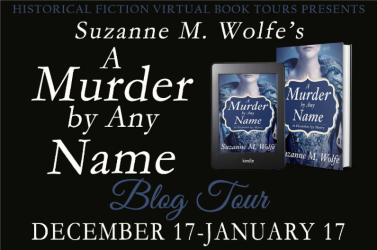
A Murder By Any Name
By Suzanne M. Wolfe
When a brutal murder threatens the sanctity of the Elizabethan court, it’s up to a hot-tempered spy to save the day.The court of Elizabeth I is no stranger to plotting and intrigue, but the royal retinue is thrown into chaos when the Queen’s youngest and sweetest lady-in-waiting is murdered, her body left on the high altar of the Chapel Royal in Whitehall Palace. Solving the murder will require the cunning and savvy possessed by only one man. Enter Nicholas Holt, younger brother of the Earl of Blackwell—spy, rake, and owner of the infamous Black Sheep tavern in the seedy district of Bankside. Nick quickly learns that working for the Queen is a mixed blessing. Elizabeth—salty-tongued, vain, and fiercely intelligent—can, with a glance, either reward Nick with a purse of gold or have his head forcibly removed.When a second lady-in-waiting is slain at Whitehall, the court once again reels with shock and dismay. On the trail of a diabolical killer, Nick and his faithful sidekick—an enormous Irish Wolfhound named Hector—are treading on treacherous ground, and only the killer’s head on a platter can keep them in the Queen’s good graces.“[A] promising series launch… Fans of Elizabethan historicals will be satisfied.”Publishers Weekly“An excellent series kickoff by Wolfe that cleverly highlights both the mystery and the many ills of Elizabethan times.”
Published on January 02, 2019 23:00
January 1, 2019
#NewRelease — Brandon – Tudor Knight, by Tony Riches #HistoricalFiction #Tudors @tonyriches
Brandon – Tudor KnightBy Tony Riches

From the author of the international bestselling Tudor Trilogy comes a true story of adventure, courtly love and chivalric loyalty.
Handsome, charismatic and a champion jouster, Sir Charles Brandon is the epitome of a Tudor Knight. A favourite of King Henry VIII, Brandon has a secret. He has fallen in love with Henry’s sister, Mary Tudor, the beautiful widowed Queen of France, and risks everything to marry her without the King’s consent.
Brandon becomes Duke of Suffolk, but his loyalty is tested fighting Henry’s wars in France. Mary’s public support for Queen Catherine of Aragon brings Brandon into dangerous conflict with the ambitious Boleyn family and the king’s new right-hand man, Thomas Cromwell.
Torn between duty to his family and loyalty to the king, Brandon faces an impossible decision: can he accept Anne Boleyn as his new queen?
New on Amazon UK and Amazon US

Tony Riches
 Tony Riches is a full-time UK author of best-selling historical fiction. He lives in Pembrokeshire, West Wales and is a specialist in the history of the Wars of the Roses and the lives of the early Tudors. Tony was a finalist in the 2017 Amazon Storyteller Awards and is listed 130th in the 2018 Top 200 list of the Most Influential Authors. For more information about Tony’s books please visit his website tonyriches.com and his popular blog, The Writing Desk and find him on Facebook and Twitter @tonyriches
Tony Riches is a full-time UK author of best-selling historical fiction. He lives in Pembrokeshire, West Wales and is a specialist in the history of the Wars of the Roses and the lives of the early Tudors. Tony was a finalist in the 2017 Amazon Storyteller Awards and is listed 130th in the 2018 Top 200 list of the Most Influential Authors. For more information about Tony’s books please visit his website tonyriches.com and his popular blog, The Writing Desk and find him on Facebook and Twitter @tonyriches
Published on January 01, 2019 23:00
December 31, 2018
Happy New Year from Myths, Legends, Books & Coffee Pots!
Published on December 31, 2018 23:00
The Coffee Pot Book Club
The Coffee Pot Book Club (formally Myths, Legends, Books, and Coffee Pots) was founded in 2015. Our goal was to create a platform that would help Historical Fiction, Historical Romance and Historical
The Coffee Pot Book Club (formally Myths, Legends, Books, and Coffee Pots) was founded in 2015. Our goal was to create a platform that would help Historical Fiction, Historical Romance and Historical Fantasy authors promote their books and find that sometimes elusive audience. The Coffee Pot Book Club soon became the place for readers to meet new authors (both traditionally published and independently) and discover their fabulous books.
...more
...more
- Mary Anne Yarde's profile
- 159 followers




